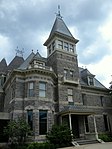St. John's Riverside Hospital
1869 establishments in New York (state)Buildings and structures in Yonkers, New YorkHospitals established in 1869Hospitals in Westchester County, New YorkHudson River ... and 2 more
Use American English from January 2019Use mdy dates from January 2019
St. John's Riverside Hospital is a private, community hospital located in Yonkers, New York. It was founded in 1869 as the first hospital in Westchester County, and shares a location and history with the Cochran School of Nursing, which was founded in 1894 as the first nursing school in Westchester. The hospital was two primary locations in Yonkers, which is the result of its merger with Yonkers General Hospital in 2001.
Excerpt from the Wikipedia article St. John's Riverside Hospital (License: CC BY-SA 3.0, Authors).St. John's Riverside Hospital
North Broadway, City of Yonkers
Geographical coordinates (GPS) Address Phone number Website Nearby Places Show on map
Geographical coordinates (GPS)
| Latitude | Longitude |
|---|---|
| N 40.968611111111 ° | E -73.886111111111 ° |
Address
Saint John's Riverside Hospital
North Broadway 967
10701 City of Yonkers
New York, United States
Open on Google Maps





